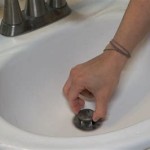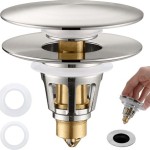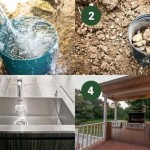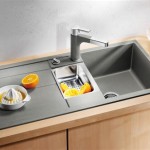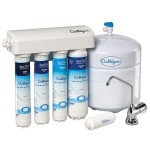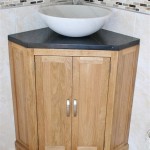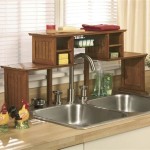Clogged Sink Past the Trap: Understanding and Addressing the Issue
A slow-draining or completely blocked sink is a common household plumbing problem. While many clogs occur within the P-trap, the curved section of pipe beneath the sink designed to prevent sewer gases from entering the home, blockages can also form further down the drain line. Understanding the potential causes and solutions for clogs located past the P-trap is crucial for effective troubleshooting and repair.
Several factors can contribute to clogs beyond the P-trap. Hair, soap scum, grease, and food particles can accumulate over time, gradually restricting water flow. In older homes, pipe corrosion or mineral buildup can also narrow the drainpipe, increasing the likelihood of clogs. Additionally, foreign objects accidentally dropped down the drain can lodge further down the line, obstructing water passage.
Diagnosing a clog located past the P-trap involves a systematic approach. If the sink is the only fixture affected, the blockage is likely within the branch drain line serving that particular sink. However, if multiple fixtures are experiencing drainage issues, the clog is likely further downstream in the main drain line.
Before attempting any DIY solutions, it's essential to assess the severity of the clog. A slow drain might respond to simple home remedies, while a complete blockage might require professional intervention. Furthermore, understanding local plumbing codes and regulations is vital before undertaking any significant plumbing work.
One of the first methods to try when dealing with a clog beyond the P-trap is using a plumbing snake or auger. These flexible tools can navigate the bends and curves of the drainpipe to break up or retrieve the blockage. Manual drain snakes are readily available at hardware stores and are suitable for less stubborn clogs. For more challenging blockages, motorized drain augers offer greater power and reach.
Chemical drain cleaners can sometimes be effective in dissolving clogs caused by organic materials like hair and grease. However, these products should be used with caution, as they contain harsh chemicals that can damage pipes and pose health risks if not handled properly. Always follow the manufacturer's instructions carefully and ensure adequate ventilation when using chemical drain cleaners. Furthermore, repeated use of chemical drain cleaners can weaken pipes over time.
If the clog persists after attempting these methods, it’s advisable to contact a licensed plumber. A professional plumber possesses the expertise and specialized tools to diagnose and address complex plumbing issues. They can use techniques like hydro jetting, which utilizes high-pressure water to clear stubborn blockages and thoroughly clean the drain line, preventing future clogs.
Preventing clogs past the P-trap involves adopting proactive measures. Regularly flushing the drain with hot water can help prevent the buildup of grease and soap scum. Installing strainers in sink drains can catch hair and other debris before they enter the plumbing system. Avoiding disposing of food scraps down the drain, especially grease and oil, can also significantly reduce the risk of clogs.
Proper disposal of grease and oil is critical for maintaining a healthy plumbing system. Instead of pouring grease down the drain, allow it to cool and solidify, then dispose of it in a sealed container. Educating household members about proper drain usage and preventative measures can contribute to a clog-free plumbing system.
In older homes, pipe corrosion or mineral buildup can contribute to recurring clogs. Consulting with a plumber about pipe replacement or relining can be a long-term solution to address these issues. Regular maintenance checks by a qualified plumber can also help identify potential problems before they escalate into major plumbing emergencies.
Understanding the different sections of your plumbing system, including the branch drain lines and the main drain line, can assist in troubleshooting drainage issues. Knowing the location of the main cleanout, an access point for cleaning the main drain line, can be helpful if a clog affects multiple fixtures in the house. However, working with the main cleanout often requires professional expertise.
While some plumbing tasks can be handled with DIY methods, it's important to recognize when professional assistance is necessary. Attempting complex plumbing repairs without proper training and tools can exacerbate the problem and potentially cause further damage to the plumbing system. A licensed plumber can provide expert advice, accurate diagnosis, and effective solutions for persistent clogs and other plumbing issues.
Maintaining a well-functioning plumbing system requires a combination of preventative measures and prompt action when problems arise. Understanding the potential causes of clogs beyond the P-trap, along with appropriate troubleshooting methods and when to seek professional help, can save homeowners time, money, and frustration in the long run.

Clear A Sink Clogged Past The Trap In Minutes Our Recipes For Success

Clear A Sink Clogged Past The Trap In Minutes Our Recipes For Success

Clear A Sink Clogged Past The Trap In Minutes Our Recipes For Success

Clear A Sink Clogged Past The Trap In Minutes Our Recipes For Success

Plumbing 101 Tackling A Clogged P Trap

Clear A Sink Clogged Past The Trap In Minutes Our Recipes For Success

How To Fix Unclog A Slow Clogged Drain Kitchen Or Bathroom Sink P Trap J Pipe Diy Draining

Clogged Drain Diy How To Unclog Your Past The Trap

How To Unclog A Kitchen Sink Home Repair Tutor

How To Fix A Kitchen Sink Clogged On Both Sides Expert Guide Clover Contracting
